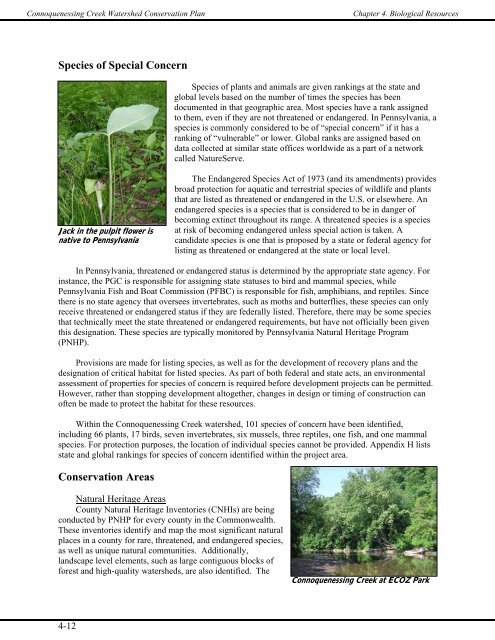CHAPTER 4 - Western Pennsylvania Conservancy
CHAPTER 4 - Western Pennsylvania Conservancy
CHAPTER 4 - Western Pennsylvania Conservancy
You also want an ePaper? Increase the reach of your titles
YUMPU automatically turns print PDFs into web optimized ePapers that Google loves.
Connoquenessing Creek Watershed Conservation Plan<br />
Chapter 4. Biological Resources<br />
Species of Special Concern<br />
Species of plants and animals are given rankings at the state and<br />
global levels based on the number of times the species has been<br />
documented in that geographic area. Most species have a rank assigned<br />
to them, even if they are not threatened or endangered. In <strong>Pennsylvania</strong>, a<br />
species is commonly considered to be of “special concern” if it has a<br />
ranking of “vulnerable” or lower. Global ranks are assigned based on<br />
data collected at similar state offices worldwide as a part of a network<br />
called NatureServe.<br />
Jack in the pulpit flower is<br />
native to <strong>Pennsylvania</strong><br />
The Endangered Species Act of 1973 (and its amendments) provides<br />
broad protection for aquatic and terrestrial species of wildlife and plants<br />
that are listed as threatened or endangered in the U.S. or elsewhere. An<br />
endangered species is a species that is considered to be in danger of<br />
becoming extinct throughout its range. A threatened species is a species<br />
at risk of becoming endangered unless special action is taken. A<br />
candidate species is one that is proposed by a state or federal agency for<br />
listing as threatened or endangered at the state or local level.<br />
In <strong>Pennsylvania</strong>, threatened or endangered status is determined by the appropriate state agency. For<br />
instance, the PGC is responsible for assigning state statuses to bird and mammal species, while<br />
<strong>Pennsylvania</strong> Fish and Boat Commission (PFBC) is responsible for fish, amphibians, and reptiles. Since<br />
there is no state agency that oversees invertebrates, such as moths and butterflies, these species can only<br />
receive threatened or endangered status if they are federally listed. Therefore, there may be some species<br />
that technically meet the state threatened or endangered requirements, but have not officially been given<br />
this designation. These species are typically monitored by <strong>Pennsylvania</strong> Natural Heritage Program<br />
(PNHP).<br />
Provisions are made for listing species, as well as for the development of recovery plans and the<br />
designation of critical habitat for listed species. As part of both federal and state acts, an environmental<br />
assessment of properties for species of concern is required before development projects can be permitted.<br />
However, rather than stopping development altogether, changes in design or timing of construction can<br />
often be made to protect the habitat for these resources.<br />
Within the Connoquenessing Creek watershed, 101 species of concern have been identified,<br />
including 66 plants, 17 birds, seven invertebrates, six mussels, three reptiles, one fish, and one mammal<br />
species. For protection purposes, the location of individual species cannot be provided. Appendix H lists<br />
state and global rankings for species of concern identified within the project area.<br />
Conservation Areas<br />
Natural Heritage Areas<br />
County Natural Heritage Inventories (CNHIs) are being<br />
conducted by PNHP for every county in the Commonwealth.<br />
These inventories identify and map the most significant natural<br />
places in a county for rare, threatened, and endangered species,<br />
as well as unique natural communities. Additionally,<br />
landscape level elements, such as large contiguous blocks of<br />
forest and high-quality watersheds, are also identified. The<br />
Connoquenessing Creek at ECOZ Park<br />
4-12














